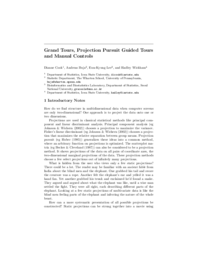Grand Tours, Projection Pursuit Guided Tours and Manual Controls
How do we find structure in multidimensional data when computer screens are only two-dimensional? One approach is to project the data onto one or two dimensions. Projections are used in classical statistical methods like principal component analysis (PCA) and linear discriminant analysis. PCA (e.g., Johnson and Wichern 2002) chooses a projection to maximize the variance. Fisher's linear discriminant (e.g., Johnson and Wichern 2002) chooses a projection that maximizes the relative separation between group means. Projection pursuit (PP) (e.g., Huber 1985) generalizes these ideas into a common strategy, where an arbitrary function on projections is optimized. The scatterplot matrix (e.g., Becker and Cleveland 1987) also can be considered to be a projection method. It shows projections of the data onto all pairs of coordinate axes, the 2-D marginal projections of the data. These projection methods choose a few select projections out of infinitely many.
@InCollection{tours,
author = {D. Cook and E.-K. Lee and A. Buja and H. Wickham},
booktitle = {Handbook of Data Visualization},
chapter = {III.2},
doi = {10.1007/978-3-540-33037-0_13},
editor = {Chunhouh Chen and Wolfgang H{\"a}rdle and Antony Unwin},
keywords = {tour},
pages = {295––314},
publisher = {Springer},
series = {Springer Handbooks of Computational Statistics},
title = {Grand Tours, Projection Pursuit Guided Tours and Manual Controls},
year = {2008},
bdsk-url-1 = {http://dx.doi.org/10.1007/978-3-540-33037-0_13},
}
